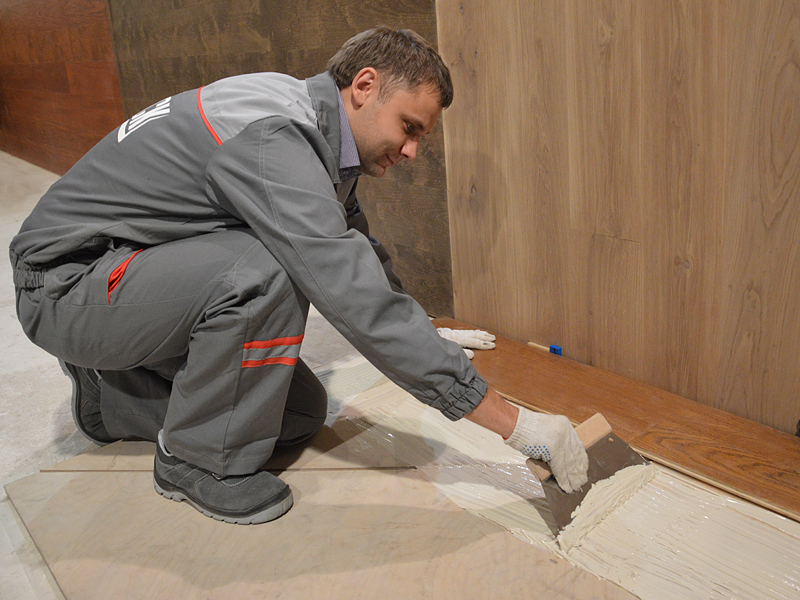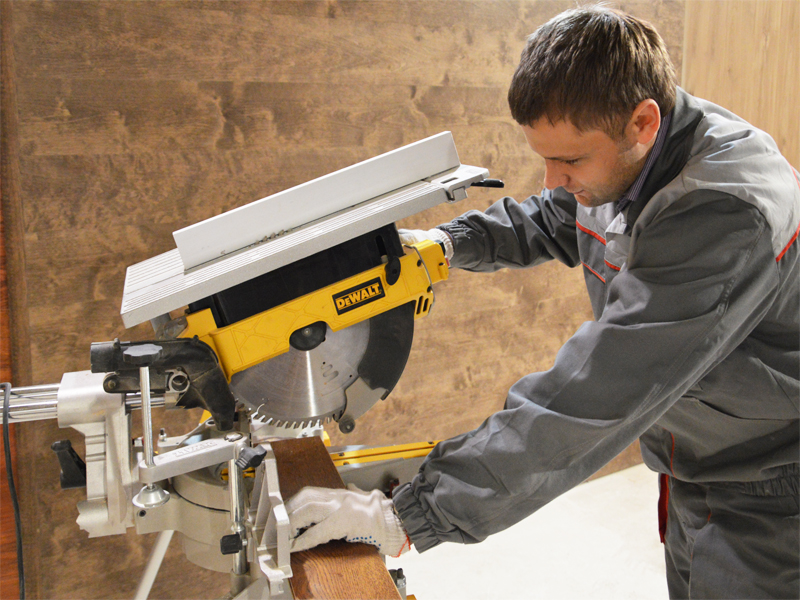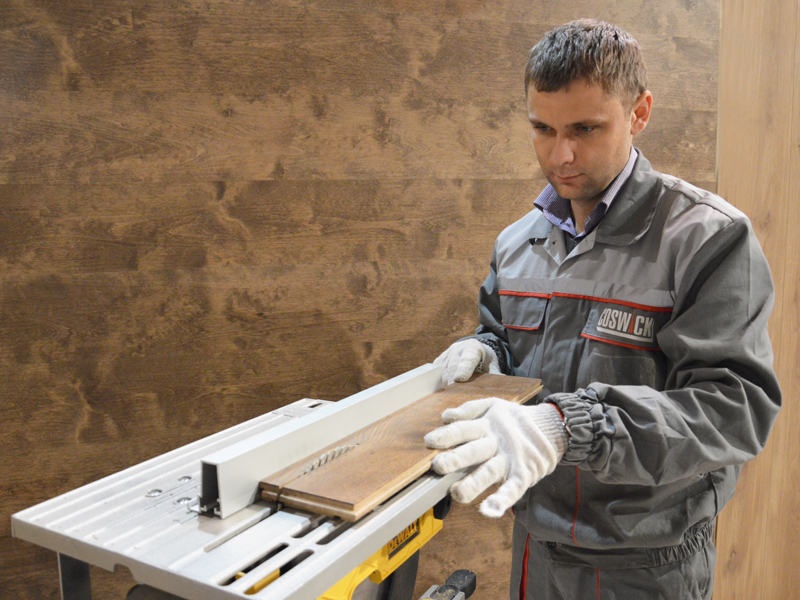INSTALLING SOLID WOOD FLOORING
Before Installation
PRODUCT USE
Coswick solid hardwood flooring can be used in all type of residential spaces, and installed on or above grade. Installation below grade or over radiant heat floor systems is not recommended and will void all warranties.
It is very important that you read and understand the information contained in this installation guide before starting, as improper installation can void the warranties.
INSTALLER/OWNER RESPONSIBILITY
It is the responsibility of the installer and/or the homeowner to inspect boards and all material for proper color, style, finish and quality prior to installation. Prior to installation, make sure that the flooring is the correct material, remove any boards/materials with which you are not satisfied. Coswick Hardwood accepts no responsibility for any costs incurred after planks with visible defects have been installed. Once installed, any plank is considered as having been accepted by both installer and owner, even if the owner was not present at the time of installation.
Keep in mind that wood is a natural product, so some color and grain variation is inevitable. Prominence of natural variation depends on the characteristics of the wood species. Coswick does not warrant against natural variations that occur from plank to plank or variations from sample to plank.
Use of filler, putty stick or stain in order to correct minor defects during installation should be accepted as normal procedure.
It is standard trade practice to allow for up to 5% margin as an allowance for cutting waste and grading variance. 5% cutting allowance must be added to the actual square footage amount.
WARRANTY
Lifetime Structural Warranty
Coswick Ltd warrants its products, in their original manufactured condition, to be free from defects in milling, drying and grading. Lifetime Structural Warranty means that the product will remain free from milling and grading defects for a lifetime in normal environmental conditions.
Finish Warranty
Coswick Ltd warrants to the original purchaser that when used under normal residential traffic conditions and maintained following Coswick Floor Maintenance Guide, factory applied CosNanoTech+ surface finish will not wear through or separate from the wood for a full twenty-five-year (25) period from the date of purchase.
Tools and Equipment
For successful installation of Coswick solid hardwood flooring, you will need the following tools and accessories:
- Hardwood floor nailer or stapler. Recommended nailers and staplers (with rubber mallet) for ¾” (19.05mm) solid boards:
– Primatech P210 pneumatic, 2” cleats
– Primatech H300 manual, 2” cleats
– Powernail 445 pneumatic or manual, 2” cleats
– Bostich MIIIFS pneumatic stapler, 2” staples
- Miter saw
- Handsaw
- Nail punch
- Claw hammer
- Crawbar
- Vacuum cleaner and broom
- Touch-up kit
- Coswick service kit
- Square
- Chalk line
- Measuring tape
- Tapping block
- Electric drill with 3/32” bit
- Finishing nails
- Wood moisture meter
- 15-lb asphalt-saturated felt paper
CAUTION: WOOD DUST
The International Agency for Research on Cancer has classified wood dust as a nasal carcinogen. The sawing, sanding, and/or machining of wood products can produce wood dust that can cause respiratory, eye and skin irritations. Wear an appropriate dust mask to reduce exposure to airborne wood dust. Avoid contact with eyes and skin. In case of irritation, flush eyes or skin with water for at least 15 minutes. In case of severe irritation, seek immediate medical attention.
Attention California Installers and Consumers: WARNING: Installation of this product may create wood dust, which is known to the State of California to cause cancer.
Subfloor Preparation
PRE-INSTALLATION CHECKLIST
Before you begin installation, make sure that the following pre-installation requirements are met:
- In order to avoid damage, hardwood flooring should be one of the last items installed during renovation.
- Prior to installation, heating and air conditioning systems must be in operation, and room temperature must have been maintained at 18-22° C (64-71°F) for at least one week.
- Relative humidity on the job site must be 45-55% at all times.
- To avoid moisture-related damages, make sure that the subfloor is dry and that the basement is well ventilated. Moisture level of wood subfloor must not exceed 12% and differential between wood planks and subfloor must be less than 4%.
- Flooring must be acclimatized on the job site under occupancy conditions for four to five days before installation. For acclimatization, flooring must be unwrapped and cartons must be opened.
RECOMMENDED SUBFLOOR SURFACES
Coswick solid hardwood flooring should be installed over wood, plywood or OSB subfloor. Particleboard is not an approved subfloor. Coswick recommends using ¾” (18-20mm) plywood or OSB panels for up to 19” (48cm) spaced joists. Minimal subfloor requirement – 5/8” (15mm) plywood or OSB panels. This subfloor is approved for up to 16” (40cm) spaced joists.
WOOD, PLYWOOD, OSB SUBFLOOR GUIDELINES AND PREPARATION
Moisture content in the subfloor should be within 4% to 12% range. Moisture level in wooden subfloor must not exceed 12%. Differential between flooring boards and subfloor must be less than 4%. If moisture level in subfloor is higher, installation has to be postponed until the source of moisture is located and removed. Turn on heaters and ensure proper room ventilation. If the source of moisture is indoors, use an air-dryer or AC. If moisture level of the subfloor is less than 4%, use an air humidifier.
To avoid squeaking in your floors, make sure that there is no movement in the subfloor. If needed, use flooring screws to fix movement. Surface of the subfloor must be absolutely flat. If necessary, flatten subfloor using a sander. Before beginning installation, clean your subfloor using a vacuum cleaner and a broom.
Note: It is the sole and joint responsibility of owner and installer to conduct pre-installation subfloor moisture checks and ensure that all conditions and specifications listed in this installation guide have been met prior to starting installation.
SUBFLOOR PREPARATION CHECKLIST
- It is the responsibility of the owner/installer to ensure that the conditions of the subfloor and jobsite are structurally acceptable prior to the installation of hardwood flooring. Coswick accepts no responsibility for deficiencies of hardwood flooring that result or are related to subfloor, sub-surface or environmental conditions on the jobsite.
- Subfloor must be clean, flat, dry and structurally sound.
- Subfloor must be clean and free of any dirt, curing compounds, sealers, drywall mud, wax, urethane, grease or any other material that may affect the integrity of flooring itself or adhesives used to install it.
- All subfloors and subfloor systems must be structurally sound and must be installed following their manufacturer’s recommendations.
- Subfloor must be thoroughly vacuumed and free from any debris, such as cleats, nail heads, dried glue or any other material.
PRE-INSTALLATION CHECKLIST
- Inspect all flooring material for color, finish, milling and grade, removing unacceptable planks.
NOTE: Coswick does not accept responsibility over any costs incurred when planks with visible defects have been installed.
- To achieve a uniform appearance across the entire floor, work from several cartons at a time. Prior to installation, “dry-lay” the flooring, mixing planks from several cartons. Ensure that the color is consistent and remove any planks with visual defects.
- Open a few boxes of hardwood flooring and arrange boards in the way you plan to install them. Boards with minor flaws can be used for trimming. Select boards, the color and texture of which match transition moldings and carpet reducers, and put them aside.
Step-by-Step Installation
Getting started:
- Lay felt paper across entire subfloor surface. Staple it to the subfloor.
- Using a chalk line trace a guideline parallel to the starting wall. Distance from the wall to the guideline should be measured as width of a single board width plus 1/2” (15mm) expansion gap. Leave 1/2” (15mm) expansion gap along all walls, and ¼” (6-7mm) at vertical ends. Expansion gap will be covered later by the baseboard and quarter round.
Installation:
- Align the first board along the guideline, moving from left to right, groove side of the plank facing the wall. Make sure you use the straightest boards for the first row.
- Because you cannot use your nailer close to the wall, the first and the last couple of rows will have to be installed using hand-nailing. Start the second row with a board which is at least 6” shorter or longer than adjacent ones.
- Nail down subsequent rows using the nailer and rubber mallet. Nail every 8”-10” (20-25cm), leaving 2”-3” (5-6cm) at the ends of every board. Every floor board has to have at least 2 nails in it.
- Note: Precise milling may require use of a tapping block for better tongue and groove fit. Never strike a rubber mallet or hammer directly on the flooring to fit the planks, as this can damage the flooring.
- The last board in each row will need to be cut. Use the remainder as the first board in the next row. Leave at least 2” gap for the last board of each row.
- Always alternate the lengths of boards so that transverse seams are positioned in a random matter, but no less than 6” (150mm) apart. This will help avoid repetitive pattern effect.
- When installing the last row, cut the board in the way that allows an expansion gap of 1/2″ (15mm).
Post-Installation:
- Install baseboards along the perimeter of the room. Nail baseboards to the wall, but not the floor.
- After installation is finished, thoroughly vacuum the floor and clean it with COSWICK hardwood floor cleaner.
- Restrict heavy foot traffic and wait 24 hours before moving furniture into the room. Place felt pads under all furniture legs.
- Make sure to set aside a few flooring planks for future repairs.
- If necessary, put a protective cover over the hardwood flooring. To cover hardwood flooring over a long period of time use only breathable materials (e.g. batting, corrugated cardboard, cardboard, quilted fabric, etc.). DO NOT cover hardwood flooring with the underfloor heating system operational or without proper insulation of heating pipes situated in the floors.
ENJOY YOUR COSWICK HARDWOOD FLOORS!



